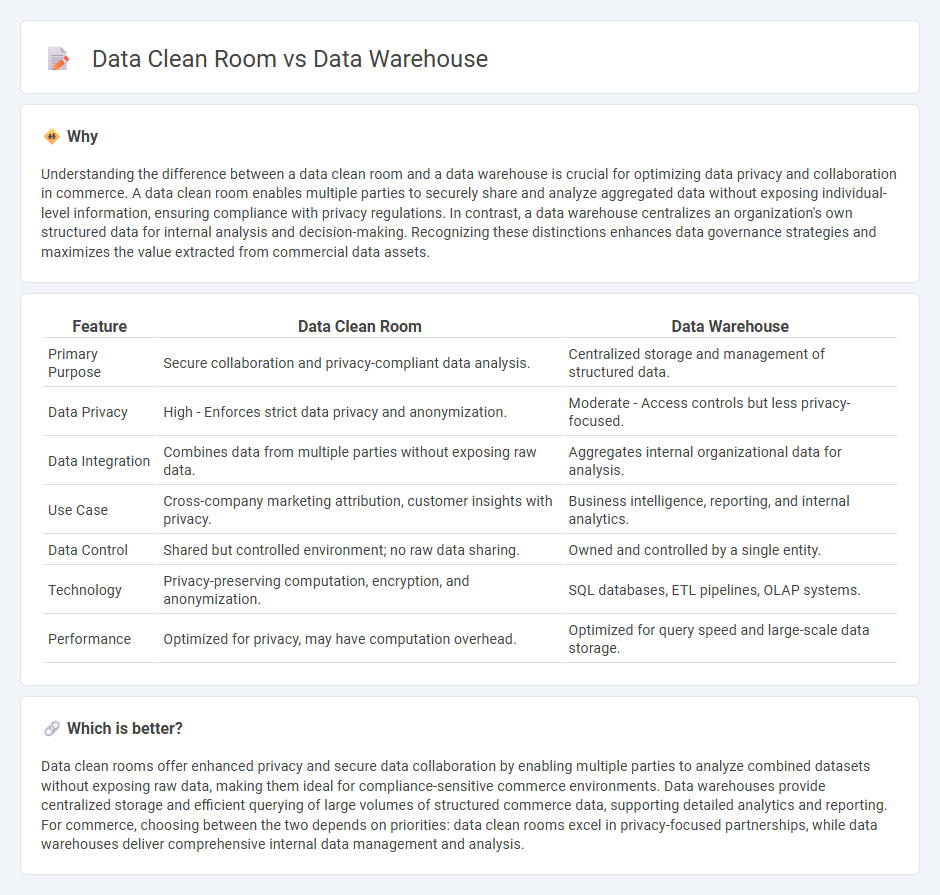
A Data Clean Room enables secure, privacy-compliant data collaboration between multiple parties without exposing raw data, enhancing marketing attribution and audience insights. In contrast, a Data Warehouse consolidates large volumes of internal data for centralized storage, querying, and analytics to support business intelligence. Explore how these technologies transform commerce data strategies.
Why it is important
Understanding the difference between a data clean room and a data warehouse is crucial for optimizing data privacy and collaboration in commerce. A data clean room enables multiple parties to securely share and analyze aggregated data without exposing individual-level information, ensuring compliance with privacy regulations. In contrast, a data warehouse centralizes an organization's own structured data for internal analysis and decision-making. Recognizing these distinctions enhances data governance strategies and maximizes the value extracted from commercial data assets.
Comparison Table
| Feature | Data Clean Room | Data Warehouse |
|---|---|---|
| Primary Purpose | Secure collaboration and privacy-compliant data analysis. | Centralized storage and management of structured data. |
| Data Privacy | High - Enforces strict data privacy and anonymization. | Moderate - Access controls but less privacy-focused. |
| Data Integration | Combines data from multiple parties without exposing raw data. | Aggregates internal organizational data for analysis. |
| Use Case | Cross-company marketing attribution, customer insights with privacy. | Business intelligence, reporting, and internal analytics. |
| Data Control | Shared but controlled environment; no raw data sharing. | Owned and controlled by a single entity. |
| Technology | Privacy-preserving computation, encryption, and anonymization. | SQL databases, ETL pipelines, OLAP systems. |
| Performance | Optimized for privacy, may have computation overhead. | Optimized for query speed and large-scale data storage. |
Which is better?
Data clean rooms offer enhanced privacy and secure data collaboration by enabling multiple parties to analyze combined datasets without exposing raw data, making them ideal for compliance-sensitive commerce environments. Data warehouses provide centralized storage and efficient querying of large volumes of structured commerce data, supporting detailed analytics and reporting. For commerce, choosing between the two depends on priorities: data clean rooms excel in privacy-focused partnerships, while data warehouses deliver comprehensive internal data management and analysis.
Connection
Data clean rooms and data warehouses connect through their role in managing and analyzing large-scale consumer data to optimize commerce strategies. A data warehouse stores vast amounts of raw transactional and behavioral data, while a data clean room ensures this data is securely processed and anonymized to protect privacy during cross-platform analysis. This integration enables businesses to gain actionable insights and personalized marketing without compromising customer confidentiality.
Key Terms
Centralized Storage
A data warehouse centralizes large volumes of structured data from multiple sources, enabling efficient querying and analysis within a secure, managed environment. In contrast, a data clean room provides a privacy-focused space where multiple parties can collaboratively analyze combined datasets without directly exposing raw data, preserving confidentiality and compliance. Explore how centralized storage solutions optimize data integration and privacy by learning more about data warehouses and clean rooms.
Privacy Compliance
Data warehouses store large volumes of structured data to support analytics and reporting, but often require strict governance to ensure compliance with privacy regulations like GDPR and CCPA. Data clean rooms provide a privacy-first environment for multiple parties to share and analyze encrypted data collaboratively without exposing personally identifiable information (PII). Explore detailed comparisons to understand how each solution enhances privacy compliance in data management strategies.
Data Collaboration
Data warehouses centralize vast amounts of structured data from multiple sources to enable comprehensive analytics and reporting, while data clean rooms facilitate secure, privacy-compliant data collaboration by allowing multiple parties to jointly analyze data without directly sharing raw datasets. Data clean rooms leverage encryption and anonymization techniques to ensure that sensitive information remains confidential, making them essential for industries with strict data privacy regulations. Explore how these technologies can enhance your organization's data collaboration strategies and compliance.
Source and External Links
What is a Data Warehouse? - A data warehouse is a central repository that consolidates data from various sources to support fast query performance and analytics for informed business decisions, involving a tiered architecture with fast and cost-efficient storage layers.
What Is a Data Warehouse? - It is a specialized data management system designed for business intelligence activities, storing large historical data sets from multiple sources to provide a single source of truth and support comprehensive analytics.
Data warehouse - Wikipedia - A data warehouse is an enterprise system optimized for reporting and analysis, integrating current and historical data from disparate sources, often using ETL processes, and serving as a core BI component for decision-making.
 dowidth.com
dowidth.com